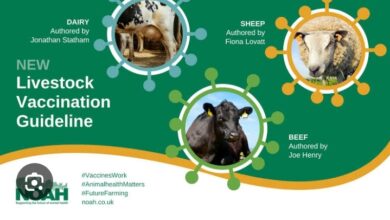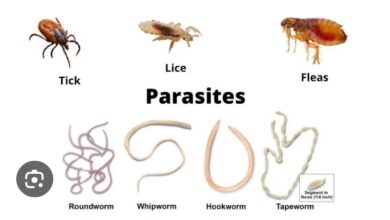Foot and Mouth Disease in livestock Overview

Foot and Mouth Disease (FMD) in livestock:
1. Introduction to FMD
Foot and Mouth Disease (FMD) is one of the most economically devastating livestock diseases globally. It is caused by a highly infectious virus that affects cloven-hoofed animals, such as cattle, pigs, sheep, goats, buffalo, and wild ungulates like deer.
The disease is not typically fatal in adults, but it severely impacts productivity, causes trade restrictions, and demands strict control measures. Outbreaks can lead to the culling of thousands or even millions of animals in affected regions.
2. The Virus
- FMD Virus (FMDV): Belongs to the genus Aphthovirus, family Picornaviridae.
- It has 7 distinct serotypes:
- O
- A
- C (largely extinct)
- SAT1
- SAT2
- SAT3
- Asia1
Each serotype requires a different vaccine, and immunity to one type does not protect against another. This diversity complicates vaccination and surveillance efforts.
3. How FMD Spreads
- Direct Transmission of foot-and-mouthdisease:
- Through saliva, vesicle fluid, milk, urine, feces, and semen.
- Indirect foot and Mouth disease Transmission:
- Via contaminated tools, feed, vehicles, water, clothing, and even people.
- Airborne foot and mouth disease Transmission:
- The virus can travel long distances (up to 60 km over land or 300 km over water) under favorable weather and environmental conditions.
- Carrier State:
- Some animals can become carriers, particularly cattle, and harbor the virus without showing signs.
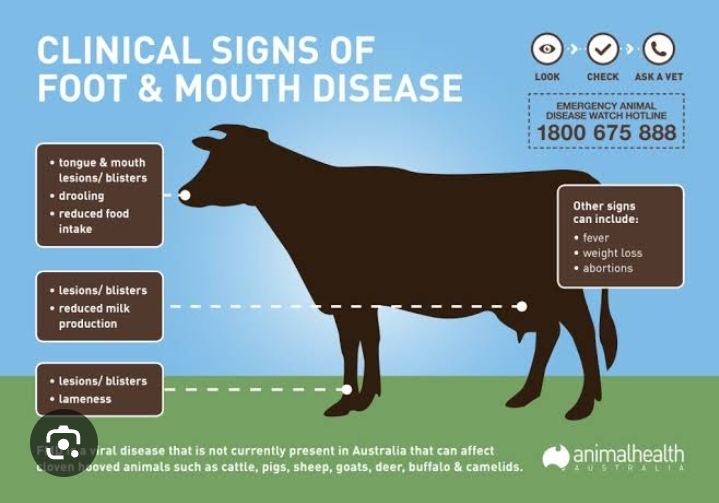
4. Clinical Signs Of Foot and Mouth Disease
Symptoms vary slightly among species:
Lets see clinical signs of foot and mouth in Cattle:
- High fever (up to 41°C)
- Blisters on the tongue, lips, gums, teats, and between the hooves
- Excessive salivation (“stringy” drool)
- Lameness, reluctance to move
- Sudden drop in milk yield
- Loss of appetite and weight loss
In Pigs:
- Severe lameness, often the first sign
- High mortality in piglets due to heart failure (myocarditis)
- Vesicles on snout and feet
Sheep and Goats:
- Symptoms are often mild or subclinical
- Blisters on the dental pad and feet
- Risk of spreading the virus unnoticed
5. Diagnosis in foot-and-mouth disease
- Clinical Examination: Based on vesicles and lameness
- Laboratory Testing:
- RT-PCR (detects viral RNA)
- ELISA (detects antibodies or antigens)
- Virus isolation and serotyping
- Differential Diagnosis: Must be distinguished from similar diseases like vesicular stomatitis, bluetongue, or swine vesicular disease.
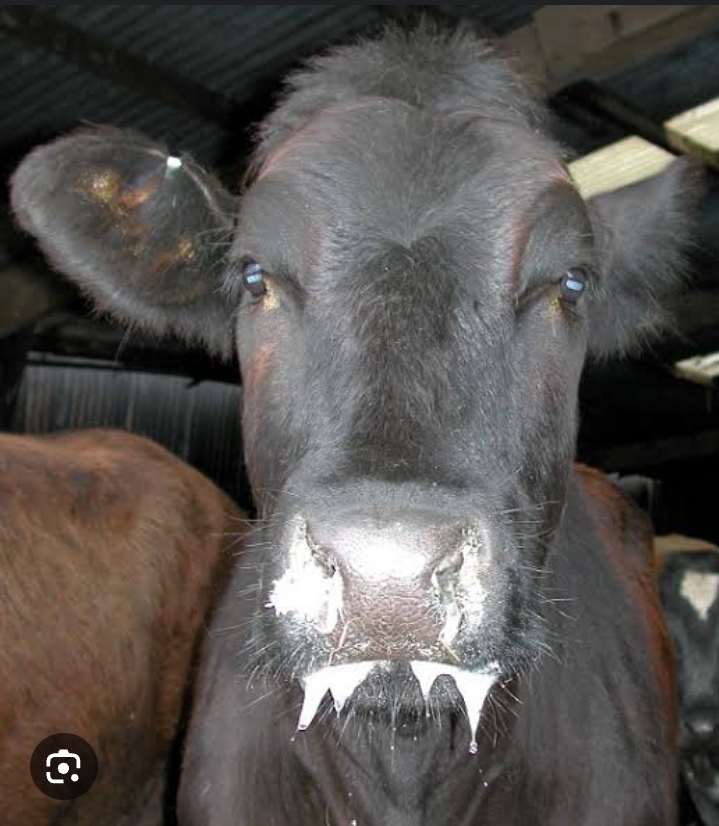
6. Prevention and Control of Foot-and-mouth disease
A. Biosecurity Measures:
- Restrict movement of animals
- Disinfect clothing, footwear, equipment
- Isolate new or returning animals
- Control access to farms
B. Vaccination:
- Used in endemic areas or during outbreaks
- Requires knowledge of circulating serotypes
- Immunity lasts only a few months to a year, needing frequent re-vaccination
C. Culling and Quarantine:
- In countries where FMD is not endemic, infected and exposed animals are often slaughtered and disposed of
- Quarantine zones and movement bans are enforced
D. Surveillance and Reporting:
- Early detection is critical
- Farmers must report signs immediately to veterinary authorities
7. Economic and Social Impact
- Trade Restrictions: Countries with FMD outbreaks face bans on exporting animals and animal products.
- Costs of Control: Vaccination campaigns, culling, compensation, surveillance, and restocking are extremely costly.
- Production Losses: Reduced milk, meat, and growth rates.
- Social Impact: Devastating for rural livelihoods dependent on livestock.
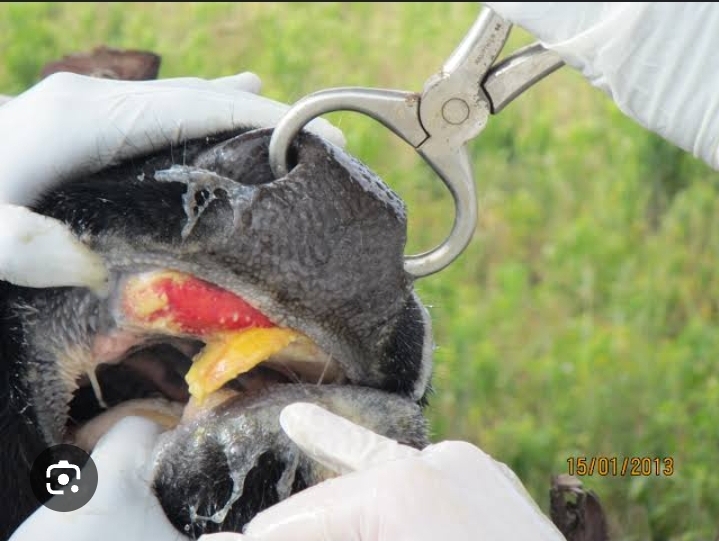
8. Human Health
- FMD is not considered a public health threat. In extremely rare cases, humans may develop mild symptoms like fever or blisters, usually from handling infected animals, but it’s not a zoonosis of concern.
9. Global Situation
- The disease is endemic in parts of Africa, Asia, and the Middle East.
- FMD-free countries (like the U.S., Australia, and many in Europe) maintain strict import controls and surveillance to prevent entry.
10. Conclusion
Did you know that FMD remains a global concern for animal health, food security, and international trade. Effective control relies on a combination of surveillance, vaccination, movement control, and international cooperation. Continuous research is needed for better vaccines and rapid diagnostics.
Lets see which Areas Foot-and-Mouth Disease (FMD): Most Affected Animals and Regions
In our Industry Foot-and-mouth disease (FMD) is a highly contagious viral illness that affects cloven-hoofed animals, both domestic and wild. The disease is caused by the foot-and-mouth disease virus (FMDV), a member of the Aphthovirus genus within the Picornaviridae family.
It spreads rapidly among animals and can cause severe economic damage, especially in regions reliant on livestock farming.
The animals most commonly affected by FMD include cattle, pigs, sheep, goats, and deer. Among these, cattle are particularly vulnerable and often exhibit the most pronounced clinical signs, such as high fever, excessive drooling, lameness, and the formation of painful blisters on the mouth, tongue, feet, and teats.
Pigs are also highly susceptible and are notable for producing large quantities of virus particles, making them potent spreaders of the disease. Sheep and goats, while also vulnerable, often show milder or even subclinical symptoms, which can complicate efforts to detect and control outbreaks.
Wild animals, such as deer and antelope, can also become infected and may act as reservoirs, maintaining the virus in the environment and contributing to its spread.
Is Foot and Mouth Disease so endemic to the world
FMD is endemic in several parts of the world particularly in Africa, the Middle East, Asia, and some parts of South America. In these regions, the disease persists due to a combination of limited veterinary infrastructure to close contact between domestic and wild animals, and inadequate control measures. India, for example, reports millions of FMD cases annually due to its large livestock population and challenges in implementing nationwide vaccination programs so China and Southeast Asian countries also experience regular outbreaks.
Conversely, many countries have successfully eradicated FMD and maintain FMD-free status such as North America (United States and Canada), most of Europe, Australia, and New Zealand. These regions implement strict biosecurity and import controls to prevent the virus from entering. In FMD-free countries that even a single outbreak can result in the mass culling of animals, extensive movement restrictions and significant economic losses due to halted exports and trade embargoes.
FMD is transmitted through direct contact between animals, contaminated feed, equipment, clothing, and even airborne spread over short distances, especially among pigs. The virus is incredibly resilient and can survive in various environmental conditions, which contributes to its rapid dissemination.
Control measures include mass vaccination, quarantine, movement controls, and culling in severe cases. Despite the availability of vaccines controlling FMD remains a challenge due to the presence of multiple serotypes of the virus, which do not provide cross-protection. This necessitates region-specific vaccines and frequent updates.
In summary FMD is a serious transboundary animal disease that primarily affects cloven-hoofed livestock. It is most prevalent in regions with dense livestock populations and limited resources for disease control. Effective management requires international cooperation, ongoing surveillance, vaccination campaigns, and strict biosecurity measures to prevent and contain outbreaks.
Look at Other: Animal Diseases

